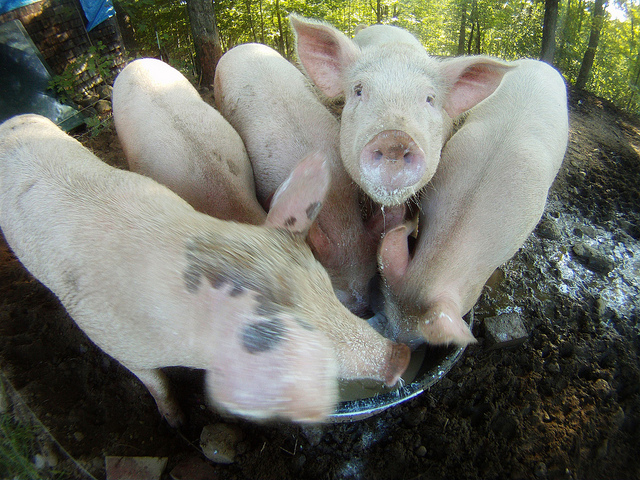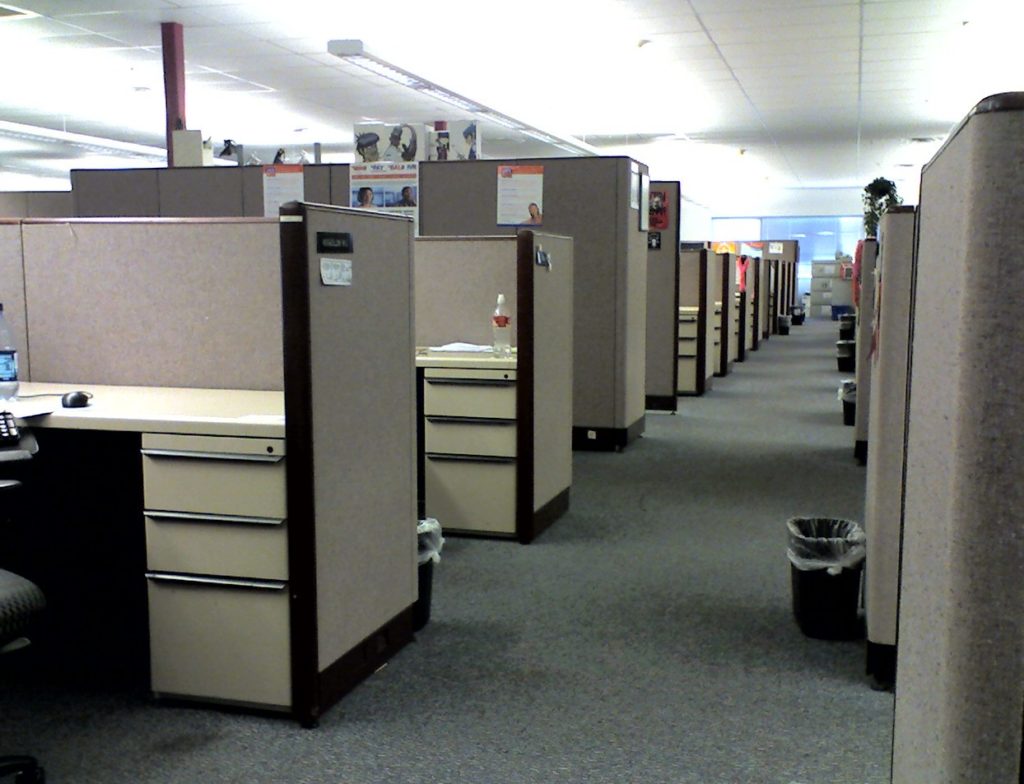Archive for the ‘Top Line Growth’ Category
Before solving, learn more about the problem.
 Ideas are cheap, but converting them into a saleable product and building the engine to make it all happen is expensive. Before spending the big money, spend more time than you think reasonable to answer these three questions.
Ideas are cheap, but converting them into a saleable product and building the engine to make it all happen is expensive. Before spending the big money, spend more time than you think reasonable to answer these three questions.
Is the problem big enough? There’s no sense spending the time and money to solve a problem unless you have a good idea the payback is worth the cost. Before spending the money to create the solution, spend the time to assess the benefits that will come from solving the problem.
Before you can decide if the problem is big enough, you have to define the problem and know who has it. One of the best ways to do this is to define how things are done today. Draw a block diagram that defines the steps potential customers follow or draw a picture of how they do things today. Define the products/services they use today and ask them what it would mean if you solved their problem. What’s particularly difficult at this point is they may not know they have a problem.
But before moving on, formalize who has the problem. Define the attributes of the potential customers and figure out how many have the same attributes and, possibly, the same problem. Define the segments narrowly to make sure each segment does, in fact, have the same problem. There will be a tendency to paint with broad strokes to increase the addressable market, but stay narrow and maintain focus on a tight group of potential customers.
Estimate the value of the solution based on how it compares to the existing alternative. And the only ones who can give you this information are the potential customers. And the only way they can give you the information is if you interview them and watch them work. And with this detailed knowledge, figure out the number of potential customers who have the problem. Do all this BEFORE any solving.
Will they pay for it? The only way to know if potential customers will pay for your solution is to show them an offering – a description of your value proposition and how it differs from the existing alternatives, a demo (a mockup of a solution and not a functional prototype) and pricing. (See LEANSTACK for more on an offering.) There will be a tendency to wait until the solution is ready, but don’t wait. And there will be a reluctance attach a price to the solution, but that’s the only way you’ll know how much they value your solution. And there will be difficulty defining a tight value proposition because that requires you to narrowly define what the solution does for the potential customer. And that’s scary because the value proposition will be clear and understandable and the potential customer will understand it well enough to decide they if they like it or not.
If you don’t assign a price and ask them to buy it, you’ll never know if they’ll buy it in real life.
Can you deliver it? List all the elements that must come together. Can you make it? Can you sell it? Can you ship it? Can you service it? Are your partners capable and committed? Do you have the money do put everything in place?
Like with a chain, it takes one bad link to make the whole thing fall apart. Figure out if any of your links are broken or missing. And don’t commit resources until they’re all in place and ready to go.
Image credit — Matthias Ripp
Growth Isn’t The Answer
 Most companies have growth objectives – make more, sell more and generate more profits. Increase profit margin, sell into new markets and twist our products into new revenue. Good news for the stock price, good news for annual raises and plenty of money to buy the things that will help us grow next year. But it’s not good for the people that do the work.
Most companies have growth objectives – make more, sell more and generate more profits. Increase profit margin, sell into new markets and twist our products into new revenue. Good news for the stock price, good news for annual raises and plenty of money to buy the things that will help us grow next year. But it’s not good for the people that do the work.
To increase sales the same sales folks will have to drive more, call more and do more demos. Ten percent more work for three percent more compensation. Who really benefits here? The worker who delivers ten percent more or the company that pays them only three percent more? Pretty clear to me it’s all about the company and not about the people.
To increase the number of units made implies that there can be no increase in the number of people required to make them. To increase throughput without increasing headcount, the production floor will have less time for lunch, less time for improving their skills and less time to go to the bathroom. Sure, they can do Lean projects to eliminate waste, as long as they don’t miss their daily quota. And sure, they can help with Six Sigma projects to reduce variation, as long as they don’t miss TAKT time. Who benefits more – the people or the company?
Increased profit margin (or profit percentage) is the worst offender. There are only two ways to improve the metric – sell it for more or make it for less. And even better than that is to sell it for more AND make it for less. No one can escape this metric. The sales team must meet with more customers; the marketing team must work doubly hard to define and communicate the value proposition; the engineering staff must reduce the time to launch the product and make it perform better than their best work; and everyone else must do more with less or face the chopping block.
In truth, corporate growth is the fundamental behind global warming, reduced life expectancy in the US and the ridiculous increase in the cost of healthcare. Growth requires more products and more products require more material mined, pumped or clear-cut from the planet. Growth puts immense pressure on the people doing the work and increases their stress level. And when they can’t deliver, their deep sense of helplessness and inadequacy causes them to kill themselves. And healthcare costs increase because the companies within (and insuring) the system need to make more profit. Who benefits here? The people in our community? The people doing the work? The planet? Or the companies?
What if we decided that companies could not grow? What if instead companies paid dividends to the people do the work based on the profit the company makes? With constant output wouldn’t everyone benefit year-on-year?
What if we decided output couldn’t grow? What if instead, as productivity increased, companies required people to work fewer hours? What if everyone could make the same number of products in seven hours and went home an hour early, working seven and getting paid for eight? Would everyone be better off? Wouldn’t the planet be better off?
What if we decided the objective of companies was to employ more people and give them a sense of purpose and give meaning to their lives? What if we used the profit created by productivity improvements to employ more people? Wouldn’t our communities benefit when more people have good jobs? Wouldn’t people be happier because they can make a contribution to their community? Wouldn’t there be less stress and fewer suicides when parents have enough money to feed their kids and buy them clothes? Wouldn’t everyone benefit? Wouldn’t the planet benefit?
Year-on-year growth is a fallacy. Year-on-year growth stresses the planet and the people doing the work. Year-on-year growth is good for no one except the companies demanding year-on-year growth.
The planet’s resources are finite; people’s ability to do work is finite; and the stress level people can tolerate is finite. Why not recognize these realities?
And why not figure out how to structure companies in a way that benefits the owners of the company, the people doing the work, the community where the work is done and the planet?
Image credit – Ryan
How To Innovate Within a Successful Company
 If you’re trying to innovate within a successful company, I have one word for you: Don’t.
If you’re trying to innovate within a successful company, I have one word for you: Don’t.
You can’t compete with the successful business teams that pay the bills because paying the bills is too important. No one in their right mind should get in the way of paying them. And if you do put yourself in the way of the freight train that pays the bills you’ll get run over. If you want to live to fight another day, don’t do it.
If an established business has been growing three percent year-on-year, expect them to grow three percent next year. Sure, you can lather them in investment, but expect three and a half percent. And if they promise six percent, don’t believe them. In fairness, they truly expect they can grow six percent, but only because they’re drinking their own Cool-Aid.
Rule 1: If they’re drinking their own Cool-Aid, don’t believe them.
Without a cataclysmic problem that threatens the very existence of a successful company, it’s almost impossible to innovate within its four walls. If there’s no impending cataclysm, you have two choices: leave the four walls or don’t innovate.
It’s great to work at successful company because it has a recipe that worked. And it sucks to work at a successful company because everyone thinks that tired old recipe will work for the next ten years. Whether it will work for the next ten or it won’t, it’s still a miserable place to work if you want to try something new. Yes, I said miserable.
What’s the one thing a successful company needs? A group of smart people who are actively dissatisfied with the status quo. What’s the one thing a successful company does not tolerate? A group of smart people who are actively dissatisfied with the status quo.
Some experts recommend leveraging (borrowing) resources from the established businesses and using them to innovate. If the established business catches wind that their borrowed resources will be used to displace the status quo, the resources will mysteriously disappear before the innovation project can start. Don’t try to borrow resources from established businesses and don’t believe the experts.
Instead of competing with established businesses for resources, resources for innovation should be allocated separately. Decide how much to spend on innovation and allocate the resources accordingly. And if the established businesses cry foul, let them.
Instead of borrowing resources from established businesses to innovate, increase funding to the innovation units and let them buy resources from outside companies. Let them pay companies to verify the Distinctive Value Proposition (DVP); let them pay outside companies to design the new product; let them pay outside companies to manufacture the new product; and let them pay outside companies to sell it. Sure, it will cost money, but with that money you will have resources that put their all into the design, manufacture and sale of the innovative new offering. All-in-all, it’s well worth the money.
Don’t fall into the trap of sharing resources, especially if the sharing is between established businesses and the innovative teams that are charged with displacing them. And don’t fall into the efficiency trap. Established businesses need efficiency, but innovative teams need effectiveness.
It’s not impossible to innovate within a successful company, but it is difficult. To make it easier, error on the side of doing innovation outside the four walls of success. It may be more expensive, but it will be far more effective. And it will be faster. Resources borrowed from other teams work the way they worked last time. And if they are borrowed from a successful team, they will work like a successful team. They will work with loss aversion. Instead of working to bring something to life they will work to prevent loss of what worked last time. And when doing work that’s new, that’s the wrong way to work.
The best way I know to do innovation within a successful company is to do it outside the successful company.
Image credit – David Doe
Cubicles – just say no.
Whether it’s placing machine tools on the factory floor or designing work spaces for people that work at the company, the number one guiding metric is resources per square foot. If you’re placing machine tools, this metric causes the machines to be stacked closely together, where the space between them is minimized, access to the machines is minimized, and the aisles are the smallest they can be. The result – the number of machines per square foot is maximized.
And though there has been talk of workplaces that promote effective interactions and creativity, the primary metric is still people per square foot. Don’t believe me? I have one word for you – cubicles. Cubicles are the design solution of choice when you want to pack the most people into the smallest area.
Here’s a test. At your next team meeting, ask people to raise their hand if they hate working in a cubicle. I rest my case.
With cubicles, it’s the worst of both worlds. There is none of the benefit of an office and none of the benefit of collaborative environment. They are half of neither.
What is one of Dilbert’s favorite topic? Cubicles.
If no one likes them, why do we still have them? If you want quiet, cubicles are the wrong answer. If you want effective collaboration, cubicles are the wrong answer. If everyone hates them, why do we still have them?
When people need to do deep work, they stay home so they can have peace and quiet. When people they want to concentrate, they avoid cubicles at all costs. When you need to focus, you need quiet. And the best way to get quiet is with four walls and a door. Some would call that and office, but those are passe. And in some cases, they are outlawed. In either case, they are the best way to get some quiet time. And, as a side benefit, they also block interruptions.
Best way for people to interact is face-to-face. And in order to interact at way, they’ve got to be in the same place at the same time. Sure spontaneous interactions are good, but it’s far better to facilitate interactions with a fixed schedule. Like with a bus stop schedule, people know where to be and when. In that way, many people can come together efficiently and effectively and the number of interactions increases dramatically. So why not set up planned interactions at ten in the morning and two in the afternoon?
I propose a new metric for facilities design – number of good ideas per square foot. Good ideas require deep thought, so quiet is important. And good ideas require respectful interaction with others, so interactions are important.
I’m not exactly sure what a facility must look like to maximize the number of good ideas per square foot, but I do know it has no cubicles.
Image credit – Tim Patterson
For innovation to flow, drive out fear.
The primary impediment to innovation is fear, and the prime directive of any innovation system should be to drive out fear.
A culture of accountability, implemented poorly, can inject fear and deter innovation. When the team is accountable to deliver on a project but are constrained to a fixed scope, a fixed launch date and resources, they will be afraid. Because they know that innovation requires new work and new work is inherently unpredictable, they rightly recognize the triple accountability – time, scope and resources – cannot be met. From the very first day of the project, they know they cannot be successful and are afraid of the consequences.
A culture of accountability can be adapted to innovation to reduce fear. Here’s one way. Keep the team small and keep them dedicated to a single innovation project. No resource sharing, no swapping and no double counting. Create tight time blocks with clear work objectives, where the team reports back on a fixed pitch (weekly, monthly). But make it clear that they can flex on scope and level of completeness. They should try to do all the work within the time constraints but they must know that it’s expected the scope will narrow or shift and the level of completeness will be governed by the time constraint. Tell them you believe in them and you trust them to do their best, then praise their good judgement at the review meeting at the end of the time block.
Innovation is about solving new problems, yet fear blocks teams from trying new things. Teams like to solve problems that are familiar because they have seen previous teams judged negatively for missing deadlines. Here’s the logic – we’d rather add too little novelty than be late. The team would love to solve new problems but their afraid, based on past projects, that they’ll be chastised for missing a completion date that’s disrespectful of the work content and level of novelty. If you want the team to solve new problems, give them the tools, time, training and a teacher so they can select different problems and solve them differently. Simply put – create the causes and conditions for fear to quietly slink away so innovation will flow.
Fear is the most powerful inhibitor. But before we can lessen the team’s fear we’ve got to recognize the causes and conditions that create it. Fear’s job is to keep us safe, to keep us away from situations that have been risky or dangerous. To do this, our bodies create deep memories of those dangerous or scary situations and creates fear when it recognizes similarities between the current situation and past dangerous situations. In that way, less fear is created if the current situation feels differently from situations of the past where people were judged negatively.
To understand the causes and conditions that create fear, look back at previous projects. Make a list of the projects where project members were judged negatively for things outside their control such as: arbitrary launch dates not bound by the work content, high risk levels driven by unjustifiable specifications, insufficient resources, inadequate tools, poor training and no teacher. And make a list of projects where team members were praised. For the projects that praised, write down attributes of those projects (e.g., high reuse, low technical risk) and their outcomes (e.g., on time, on cost). To reduce fear, the project team will bend new projects toward those attributes and outcomes. Do the same for projects that judged negatively for things outside the project teams’ control. To reduce fear, the future project teams will bend away from those attributes and outcomes.
Now the difficult parts. As a leader, it’s time to look inside. Make a list of your behaviors that set (or contributed to) causes and conditions that made it easy for the project team to be judged negatively for the wrong reasons. And then make a list of your new behaviors that will create future causes and conditions where people aren’t afraid to solve new problems in new ways.
Image credit — andrea floris
You can’t innovate when…
Your company believes everything should always go as planned.
You still have to do your regular job.
The project’s completion date is disrespectful of the work content.
Your company doesn’t recognize the difference between complex and complicated.
The team is not given the tools, training, time and a teacher.
You’re asked to generate 500 ideas but you’re afraid no one will do anything with them.
You’re afraid to make a mistake.
You’re afraid you’ll be judged negatively.
You’re afraid to share unpleasant facts.
You’re afraid the status quo will be allowed to squash the new ideas, again.
You’re afraid the company’s proven recipe for success will stifle new thinking.
You’re afraid the project team will be staffed with a patchwork of part time resources.
You’re afraid you’ll have to compete for funding against the existing business units.
You’re afraid to build a functional prototype because the value proposition is poorly defined.
Project decisions are consensus-based.
Your company has been super profitable for a long time.
The project team does not believe in the project.
Image credit Vera & Gene-Christophe
Choosing What To Do
 In business you’ve got to do two things: choose what to do and choose how to do it well. I’m not sure which is more important, but I am sure there’s far more written on how to do things well and far less clarity around how to choose what to do.
In business you’ve got to do two things: choose what to do and choose how to do it well. I’m not sure which is more important, but I am sure there’s far more written on how to do things well and far less clarity around how to choose what to do.
Choosing what to do starts with understanding what’s being done now. For technology, it’s defining the state-of-the-art. For the business model, it’s how the leading companies are interacting with customers and which functions they are outsourcing and which they are doing themselves. In neither case does what’s being done define your new recipe, but in both cases it’s the first step to figuring how you’ll differentiate over the competition.
Every observation of the state-of-the-art technologies and latest business models is a snapshot in time. You know what’s happening at this instant, but you don’t know what things will look like in two years when you launch. And that’s not good enough. You’ve got to know the improvement trajectories; you’ve got to know if those trajectories will still hold true when you’ll launch your offering; and, if they’re out of gas, you’ve got to figure out the new improvement areas and their trajectories.
You’ve got to differentiate over the in-the-future competition who will constantly improve over the next two years, not the in-the-moment competition you see today.
For technology, first look at the competitions’ websites. For their latest product or service, figure out what they’re proud of, what they brag about, what line of goodness it offers. For example, is it faster, smaller, lighter, more powerful or less expensive? Then, look at the product it replaced and what it offered. If the old was faster than the one it replaced and the newest one was faster still, their next one will try to be faster. But if the old one was faster than the one it replaced and the newest one is proud of something else, it’s likely they’ll try to give the next one more of that same something else.
And the rate of improvement gives another clue. If the improvement is decreasing over time (old product to new product), it’s likely the next one will improve on a new line of goodness. If it’s still accelerating, expect more of what they did last time. Use the slope to estimate the magnitude of improvement two years from now. That’s what you’ve got to be better than.
And with business models, make a Wardley Map. On the map, place the elements of the business ecosystem (I hate that word) and connect the elements that interact with each other. And now the tricky part. Move to the right the mature elements (e.g., electrical power grid), move to the middle the immature elements (things that are clunky and you have to make yourself) and move to the middle the parts you can buy from others (products). There’s a north-south element to the maps, but that’s for another time.
The business model is defined by which elements the company does itself, which it buys from others and which new ones they create in their labs. So, make a model for each competitor. You’ll be able to see their business model visually.
Now, which elements to work on? Buy the ones you can buy (middle), improve the immature ones on the far left so they move toward the central region (product) and disrupt the lazy utilities (on the right) with some crazy technology development and create something new on the far left (get something running in the lab).
Choosing what to work on starts with Observation of what’s going on now. Then, that information is Oriented with analysis, synthesis and diverse perspective. Then, using the best frameworks you know, a Decision is made. And then, and only then, can you Act.
And there you have it. The makings of an OODA loop-based methodology for choosing what to do.
For a great podcast on John Boyd, the father of the OODA loop, try this one.
And for the deepest dive on OODA (don’t start with this one) see Osinga – Science, Strategy and War.
Make life easy for your customers.
 Companies that have products want to improve them year-on-year. This year’s must be better than last year’s. For selfish reasons, we like to improve cost, speed and quality. Cost reduction drops profit directly to the bottom line. Increased speed reduces overhead (less labor per unit) and increases floor space productivity (more through the factory). Improved quality reduces costs. And for our customers, we like to improve their productivity by helping them do more value-added work with fewer resources. More with less! But there’s a problem – every year it gets more difficult to improve on last year, especially with our narrowly-defined view of what customers value.
Companies that have products want to improve them year-on-year. This year’s must be better than last year’s. For selfish reasons, we like to improve cost, speed and quality. Cost reduction drops profit directly to the bottom line. Increased speed reduces overhead (less labor per unit) and increases floor space productivity (more through the factory). Improved quality reduces costs. And for our customers, we like to improve their productivity by helping them do more value-added work with fewer resources. More with less! But there’s a problem – every year it gets more difficult to improve on last year, especially with our narrowly-defined view of what customers value.
And some companies talk about creating the next generation business model, though no one’s quite sure of what the business model actually is and what makes for a better one.
To break out of our narrow view of “better” and to avoid endless arguments over business models, I suggest an approach based on a simple mantra – Make It Easy.
Make it easy for the customer to _____________.
And take a broad view of what customers actually do. Here are some ideas:
Make it easy to find you. If they can’t find you, they can’t buy from you.
Make it easy to understand what you do and why you do it. Give them a reason to buy.
Make it easy to choose the right solution. No one likes buying the wrong thing.
Make it easy to pay. If they need a loan, why not find one for them?
Make it easy to receive. Think undamaged, recyclable packaging, easy to get off the truck.
Make it easy to install. Don’t think user manuals, think self-installation.
Make it easy to verify it’s ready to go. No screens, no menus. One green light.
Make it easy to deliver the value-added benefit. We over-focus here and can benefit by thinking more broadly. Make it easy to set up, easy to verify the setup, easy to know how to use it, easy change over to the next job.
Make it easy to know the utilization. The product knows when it’s being used, why not give it the authority to automatically tell people how much free time it has?
Make it easy to maintain. When the fastest machine in the world is down for the count, it becomes tied for the slowest machine in the world. Make it easy to know what needs be replaced and when, make it easy to know how to replace it, make it easy to order the replacement parts, make it easy to verify the work was done correctly, make it easy to notify that the work was done correctly, and make it easy to reset the timers.
Make it easy to troubleshoot. Even the best maintenance programs don’t eliminate all the problems. Think auto-diagnosis. Then, like with maintenance, all the follow-on work should be easy.
Make it easy to improve. As the product is used, it learns. It recognizes who is using it, remembers how they like it to behave, then assumes the desired persona.
Though this list is not exhaustive, it provides some food for thought. Yes, most of the list is not traditionally considered value-added activities. But, customers DO value improvements in these areas because these are the jobs they must do. If your competition is focused narrowly on productivity, why not differentiate by making it easy in a more broader sense? When you do, they’ll buy more.
And don’t argue about your business model. Instead, choose important jobs to be done and make them easier for the customer. In that way, how you prioritize your work defines your business model. Think of the business model as a result.
And for a deeper dive on how to make it easy, here’s one of my favorite posts. The takeaway – Don’t push people toward an objective. Instead, eliminate what’s in the way.
Image credit – Hernán Piñera
The Slow No
 When there’s too much to do and too few to do it, the natural state of the system is fuller than full. And in today’s world we run all our systems this way, including our people systems.
When there’s too much to do and too few to do it, the natural state of the system is fuller than full. And in today’s world we run all our systems this way, including our people systems.
A funny thing happens when people’s plates are full – when a new task is added an existing one hits the floor. This isn’t negligence, it’s not the result of a bad attitude and it’s not about being a team player. This is an inherent property of full plates – they cannot support a new task without another sliding off. And drinking glasses have this same interesting property – when full, adding more water just gets the floor wet.
But for some reason we think people are different. We think we can add tasks without asking about free capacity and still expect the tasks to get done. What’s even more strange – when our people tell us they cannot get the work done because they already have too much, we don’t behave like we believe them. We say things like “Can you do more things in parallel?” and “Projects have natural slow phases, maybe you can do this new project during the slow times.” Let’s be clear with each other – we’re all overloaded, there are no slow times.
For a long time now, we’ve told people we don’t want to hear no. And now, they no longer tell us. They still know they can’t get the work done, but they know not to use the word “no.” And that’s why the Slow No was invented.
The Slow No is when we put a new project on the three year road map knowing full-well we’ll never get to it. It’s not a no right now, it’s a no three years from now. It’s elegant in its simplicity. We’ll put it on the list; we’ll put it in the queue; we’ll put it on the road map. The trick is to follow normal practices to avoid raising concerns or drawing attention. The key to the Slow No is to use our existing planning mechanisms in perfectly acceptable ways.
There’s a big downside to the Slow No – it helps us think we’ve got things under control when we don’t. We see a full hopper of ideas and think our future products will have sizzle. We see a full road map and think we’re going to have a huge competitive advantage over our competitors. In both situations, we feel good and in both situations, we shouldn’t. And that’s the problem. The Slow No helps us see things as we want them and blocks us from seeing them as they are.
The Slow No is bad for business, and we should do everything we can to get rid of it. But, it’s engrained behavior and will be with us for the near future. We need some tools to battle the dark art of the Slow No.
The Slow No gives too much value to projects that are on the list but inactive. We’ve got to elevate the importance of active, fully-staffed projects and devalue all inactive projects. Think – no partial credit. If a project is active and fully-staffed, it gets full credit. If it’s inactive (on a list, in the queue, or on the road map) it gets zero credit. None. As a project, it does not exist.
To see things as they are, make a list of the active, fully-staffed projects. Look at the list and feel what you feel, but these are the only projects that matter. And for the road map, don’t bother with it. Instead, think about how to finish the projects you have. And when you finish one, start a new one.
The most difficult element of the approach is the valuation of active but partially-staffed projects. To break the vice grip of the Slow No, think no partial credit. The project is either fully-staffed or it isn’t And if it’s not fully-staffed, give the project zero value. None. I know this sounds outlandish, but the partially-staffed project is the slippery slope that gives the Slow No its power.
For every fully-staffed project on your list, define the next project you’ll start once the current one is finished. Three active projects, three next projects. That’s it. If you feel the need to create a road map, go for it. Then, for each active project, use the road map to choose the next projects. Again, three active projects, three next projects. And, once the next projects are selected, there’s no need to look at the road map until the next projects are almost complete.
The only projects that truly matter are the ones you are working on.
Image credit – DaPuglet
How to Choose the Best Idea
 We have too many ideas, but too few great ones. We don’t need more ideas, we need a way to choose the best one or two ideas and run them to ground.
We have too many ideas, but too few great ones. We don’t need more ideas, we need a way to choose the best one or two ideas and run them to ground.
Before creating more ideas, make a list of the ones you already have. Put them in two boxes. In Box 1, list the ideas without a video of a functional prototype in action. In Box 2, list the ideas that have a video showing a functional prototype demonstrating the idea in action. For those ideas with a functional prototype and no video, put them in Box 1.
Next, throw away Box 1. If it’s not important enough to make a crude physical prototype and create a simple video, the idea isn’t worth a damn. If someone isn’t willing to carve out the time to make a physical prototype, there’s no emotional energy behind the idea and it should be left to die. And when people complain that it’s unfair to throw away all those good ideas in Box 1, tell them it’s unfair to spend valuable resources talking about ideas that aren’t worthy. And suggest, if they want to have a discussion about an idea, they should build a physical prototype and send you the video. Box 2, or bust.
Next, get the band together and watch the short videos in Box 2, and, as a group, put them in two boxes. In Box 3, put the videos without customers actively using the functional prototype. In Box 4, put the videos with customers actively using the functional prototype.
Next, throw way Box 3. If it’s not important enough to make a trip to an important customer and create a short video, the idea isn’t worth a damn. If you’re not willing to put yourself out there and take the idea to an important customer, the idea is all fizzle and no sizzle. Meaningful ideas take immense personal energy to run through the gauntlet, and without a video of a customer using the functional prototype, there’s not enough energy behind it. And when everyone argues that Box 3 ideas are worth pursuing, tell them to pursue a video showing a most important customer demonstrating the functional prototype.
Next, get the band back together to watch the Box 4 videos. Again, put the videos in two boxes. In Box 5 put the videos where the customer didn’t say what they liked and how they’d use it. In Box 6, put the videos where the customer enthusiastically said what they liked and how they’ll use it.
Next, throw away Box 5. If the customer doesn’t think enough about the prototype to tell you how they’ll use it, it’s because they don’t think much of the idea. And when the group says the customer is wrong or the customer doesn’t understand what the prototype is all about, suggest they create a video where a customer enthusiastically explains how they’d use it.
Next, get the band back in the room and watch the Box 6 videos. Put them in two boxes. In Box 7, put the videos that won’t radically grow the top line. In Box 8, put the videos that will radically grow the top line. Throw away Box 7.
For the videos in Box 8, rank them by the amount of top line growth they will create. Put all the videos back into Box 8, except the video that will create the most top line growth. Do NOT throw away Box 8.
The video in your hand IS your company’s best idea. Immediately charter a project to commercialize the idea. Staff it fully. Add resources until adding resources doesn’t no longer pulls in the launch. Only after the project is fully staffed do you put your hand back into Box 8 to select the next best idea.
Continually evaluate Boxes 1 through 8. Continually throw out the boxes without the right videos. Continually choose the best idea from Box 8. And continually staff the projects fully, or don’t start them.
Image credit – joiseyshowaa
If you want to learn, define a learning objective.
 Innovation is all about learning. And if the objective of innovation is learning, why not start with learning objectives?
Innovation is all about learning. And if the objective of innovation is learning, why not start with learning objectives?
Here’s a recipe for learning: define what you want to learn, figure how you want to learn, define what you’ll measure, work the learning plan, define what you learned and repeat.
With innovation, the learning is usually around what customers/users want, what new things (or processes) must be created to satisfy their needs and how to deliver the useful novelty to them. Seems pretty straightforward, until you realize the three elements interact vigorously. Customers’ wants change after you show them the new things you created. The constraints around how you can deliver the useful novelty (new product or service) limit the novelty you can create. And if the customers don’t like the novelty you can create, well, don’t bother delivering it because they won’t buy it.
And that’s why it’s almost impossible to develop a formal innovation process with a firm sequence of operations. Turns out, in reality the actual process looks more like a fur ball than a flow chart. With incomplete knowledge of the customer, you’ve got to define the target customer, knowing full-well you don’t have it right. And at the same time, and, again, with incomplete knowledge, you’ve got to assume you understand their problems and figure out how to solve them. And at the same time, you’ve got to understand the limitations of the commercialization engine and decide which parts can be reused and which parts must be blown up and replaced with something new. All three explore their domains like the proverbial drunken sailor, bumping into lampposts, tripping over curbs and stumbling over each other. And with each iteration, they become less drunk.
If you create an innovation process that defines all the if-then statements, it’s too complicated to be useful. And, because the if-thens are rearward-looking, they don’t apply the current project because every innovation project is different. (If it’s the same as last time, it’s not innovation.) And if you step up the ladder of abstraction and write the process at a high level, the process steps are vague, poorly-defined and less than useful. What’s a drunken sailor to do?
Define the learning objectives, define the learning plan, define what you’ll measure, execute the learning plan, define what you learned and repeat.
When the objective is learning, start with the learning objectives.
Image credit Jean L.



 Mike Shipulski
Mike Shipulski